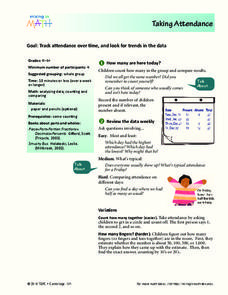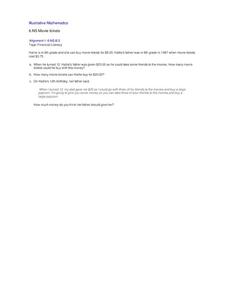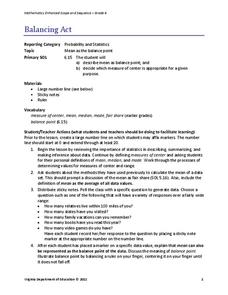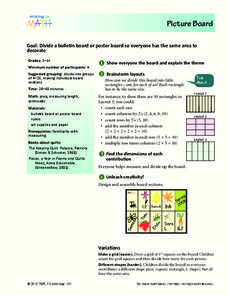Curated OER
Calculating Stride Length
How many steps does one take to walk a mile? The number of steps one walks in a mile would definitely depend on the length of his stride. Shorter people may take shorter strides, and taller people may take longer strides. This activity...
Curated OER
Reading Bar Graphs #2
Raise the bar in your third grade class with this learning exercise on bar graphs. Youngsters view three graphs representing three different sets of data, and answer questions based on what they analyze. The first set is completed as an...
Curated OER
Football Math
Develop an understanding of positive and negative numbers using football. Pupils create a football field and game pieces. The teacher gives plays and the pupils move pieces to see who wins the game.
Curated OER
Multiplication and Division Word Problems Made Easy
Marbles to learn math? What fun! Discuss the rules of multiplication and division when applied to whole numbers, decimals, and fractions. Small groups use6 marbles to design different types of multiplication and division problems, and...
Curated OER
Mass-Moles-Particles
In this moles worksheet, students define a mole and convert grams to moles or moles to molecules. Students convert specific mass of compounds to moles. This worksheet has 1 true or false, 6 short answer, 3 fill in the blank, and 15...
Curated OER
Some of the 6s
Quick! Can your mathematicians recall multiples of six in these timed exercises? There are 26 equations here, split into five distinct sections. Learners fill in products and factors, dealing with number sentences in both numeral and...
Curated OER
Word Game!
Early finishers beware! Here is a fun word game creative thinkers will really enjoy. They attempt to make as many words as they can using the word transport. Strict rules make this task a real challenge. Tip: Also great to use in a fun...
Curated OER
Atoms, Mass and The Mole
In this atoms, mass and the mole worksheet, students are given 18 problems to solve for the number of atoms, the mass of the substance or the moles of the substance. Students show their work and include all the units of measurements.
Curated OER
Taking Attendance
Young mathematicians record and analyze data. They will take attendance for their class and compare to other days. Then discuss ways to count who is present. They may also show the amount of students present using fractions.
Curated OER
Pictographs
What do these pictographs show? Scholars analyze three sets of data organized into pictographs, filling in several comprehension questions about each. The first one is done for them as an example, but consider going over it together to...
Illustrative Mathematics
Movie tickets
This is a good Common Core question that relates inflation to operations with decimals and rounding. Young learners are asked to find out if an amount of money can purchase the same amount of movie tickets in 2012 as it did in 1987. They...
Curated OER
Real-Life Problems: Money
Help your fourth graders become responsible consumers with this math learning exercise! They solve six word problems about buying toys using the four operations. An example at the top of the page helps pupils write out the necessary...
Illustrative Mathematics
Building toward fluency
Here is a great learning task that focuses on the development of areas in computational fluency including strategies in mental math. Young learners are guided through a list of addition expressions that help them visually understand the...
Curated OER
Column Addition
Third and fourth graders read the addition word problems and use the sets of numbers within the problem along with column addition to solve the problems.
Virginia Department of Education
Balancing Act
How many different interpretations of the mean are there? Scholars place numbers on a number line and determine the mean. They interpret the mean as the average value and as the balance point.
DK Publishing
Multiplying and Dividing by 10
Your scholars will be glad to know there are helpful tricks when multiplying and dividing by 10; show them this concept through visual examples as they complete these word problems. Using sets of peas they fill in four multiplication...
DK Publishing
Using Information in Tables
Find out how well can your second or third graders use tables to solve word problems by assigning this single-page activity. Two tables with different sets of data prompt learners to solve six problems. An example at the top of the page...
Curated OER
Lots of Lakes: Greater Than, Less Than
To set up this activity, your class explores Minnesota's nickname as the Land of 10,000 Lakes, and the back of the state quarter that features a Minnesota lake. Young mathematicians compare the number 1 to the number 10,000 with support...
Curated OER
Picture Board
Learners divide a poster board so everyone gets the same amount of area to decorate. Youngsters talk about the different ways to divide a rectangle. They measure their lines to make sure that each piece is equal and then decorate their...
DK Publishing
5 Times Table
Get scholars familiar with the fives multiplication facts using a hundreds chart and number sentences. They skip count by five on the chart, coloring in all numbers that are multiples of five. Do they see a pattern? Next, learners...
Curated OER
Prairie Populations
Eleventh graders practice the Quadrat Survey Technique to analyze the biodiversity of a local plant community. They compare its biodiversity with the documented changes in biodiversity of the tallgrass prairie over time.
Curated OER
2-Dimensional Shapes: Looking at Shapes
Help scholars identify shapes more thoroughly by counting their attributes. They examine eight 2-dimensional shapes, recording the number of sides and corners for each writing the name. Consider creating a class poster together before or...
DK Publishing
10 Times Table
Can scholars find the pattern as they multiply by 10? Third graders learn the beauty of number patterns as they shade in each multiple of ten in a hundreds chart. They complete 10 number sentences multiplying 10 by the numbers 1-10 (one...
World Wildlife Fund
Graphs and Charts
A two-part activity incorporating bar graphs and pie charts, young mathematicians can practice their graphing skills. Pupils answer questions using graphs and charts but are also challenged to create their own using a given set of data.























